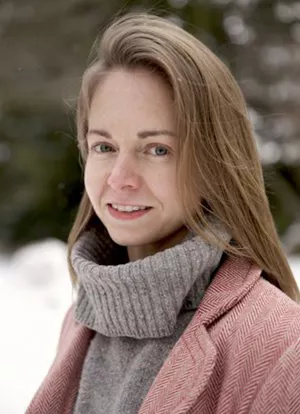Associate Professor of Dance Olivia Sabee Receives Mellon New Directions Fellowship

Olivia Sabee will soon expand her professional and academic horizons — from a familiar place.
Recipient of the prestigious Mellon New Directions Fellowship, the associate professor of dance will take master’s coursework in transnational history during the 2024-25 academic year at the École Normale Supérieure in Paris.
“Part of it is luck, and timing, but in many ways it feels like the culmination of many years of work,” says Sabee. “It’s extremely exciting.”
Sabee is eager to return to the École Normale Supérieure, where she studied on exchange during graduate school, and to the flow of graduate study itself.
“The time you have in graduate school is luxurious, and it allows you to dig into an incredible amount of material,” says Sabee, a scholar of French and Italian dance and literature. “I’m excited about this chance to expand my base competencies, in a way that’s tough to do while teaching.”
The New Directions Fellowship empowers scholars in the humanities to explore areas outside of their primary focus, “encouraging the highest standards in cross-disciplinary research.”
Sabee chose her upcoming master’s coursework for its various approaches to conceiving history. She will concentrate on France’s colonial empire with a focus on Saint-Domingue (now Haiti), as well as the migration of artists from both France and Saint-Domingue to the U.S. following the French and Haitian revolutions.
“I’m interested in how performers were moving around,” she says, “and how it transformed ballet repertory in different ways.”
The program builds upon a course, Ballet in the Atlantic World, that she taught at Swarthmore this spring. Funded by a course-development grant from Mellon, the course allowed her and her students to delve into what ballet meant in the French Antilles and the U.S. prior to 1850.
“It’s been exciting to see students thinking about history in different ways and thinking about ways to recover dance histories,” she says. “Sometimes that means standing up and trying to learn the steps or thinking about what a term meant 300 years ago, versus what it means today.
“A lot of ballet vocabulary terms still exist, but mean something radically different,” Sabee adds. “That has been fun to explore.”
Sabee also plans to take courses in Haitian Creole, to supplement her current familiarity with French and Italian traditions.
“In order to do this work, I need to learn Haitian Creole,” she says. “So I’m excited to have time and space to do that.”
Sabee views her upcoming studies as connected to her first book, Theories of Ballet in the Age of the Encyclopédie, which examined how editors and publishers shaped ideas around ballet as well as the movement of dance across geographical space.
“I’m attracted to spaces of cultural exchange,” she says. “Colonial spaces are obviously very complicated, as sites of extreme violence, and much performance practice in Saint-Domingue was part of a greater strategy of consolidating political power. Yet even despite these strong ties to the metropole, local changes were made to much of the musical theater repertory, especially where dance was concerned.”
Underpinning Sabee’s efforts is the hope that students will continue to view the historical study of dance as a serious field.
“I serve a lot of dance majors in my courses, but also think there’s something there for students interested in, for example, global studies or history,” she says. “Fundamentally, what I’m looking at is the transmission and transformation of culture.”



